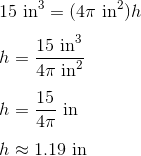This page is part of my unofficial solutions manual to the GRE Paper Practice Book (2e), a free resource available on the ETS website. They publish the questions; I explain the answers. If you haven’t worked through the Practice Book, give Section 6 a shot before reading this!
6.7: Height of a Cylinder
Only two kinds of solids (three-dimensional figures) are discussed in the GRE Math Review: rectangular solids (also known as right rectangular prisms) and right circular cylinders, which are your regular “soup can” cylinder with one base directly above the other. (A few more solids are mentioned in passing, but none of their properties are covered in the Review.)
3D geometry questions on the GRE tend to focus on two properties of solids: their surface area and their volume. For both rectangular solids and cylinders, these properties are described by simple formulas. It’s best to memorize these, so you don’t have to reinvent the wheel (or the box, or the can) on test day.
The volume of a right circular cylinder is given by the following equation:
- V is the volume of the cylinder
- r is the radius of the circular bases
- h is the height of the cylinder
If we know two of these quantities, the formula allows us to find the other. Here, we have the radius and the volume, so we can plug those into the formula for a start:
Sanity check: Remember to include the units in your calculations. This way, mistakes will be easier to catch. If we know we’re looking for height, and we get an answer in cubic inches, we know there’s been an error somewhere along the way.
From here we can solve for h in just a few steps:
Because the height (Qty. A) is less than 2 inches (Qty. B), the answer is (B).
Math Review Reference
For more on this topic, see the following section of the GRE Math Review:
- 3.6: Three-Dimensional Figures (p. 56)

